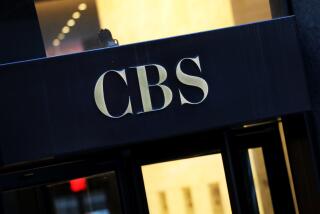Networks Share Video in Rare Cooperation
- Share via
In an unprecedented display of cooperation, the heads of every national television news organization--network and cable--agreed Tuesday morning to share the barrage of images from the terrorist attacks on the East Coast.
“There is no reason for any television news operation to be proprietary,” said CBS News spokeswoman Sandy Genelius. “Anything that anybody shoots, is available to other networks.”
The deal was proposed by Don Hewitt, longtime executive producer of CBS’s “60 Minutes,” who walked across New York City’s 57th Street and into the CBS Broadcast Center to talk to Andrew Heyward, president of CBS News. For over a year, CBS has had an agreement to share “generic video” with Fox News Service and ABC News. Hewitt wanted the agreement extended to all networks and all video.
At about 10:30 a.m. EST, Heyward called his counterparts at Fox and ABC. They agreed to share video, but not reporting. They also said if a network obtained “exclusive” images, the other networks could pick it up immediately without permission.
Heyward called NBC head Andy Lack and Walter Isaacson, chairman and chief executive of CNN News Group. “With all the other broadcast networks in on the deal, and the fact that it was a national emergency, we thought it would be prudent,” said Eason Jordan, Chief News Executive for CNN News Group. “This transcends competition. There’s just no precedence for the horror of what we saw today, at least in the history of TV news.”
Delivering the sole broadcast report from Air Force One was ABC News’ Ann Compton, the TV “pool” reporter, representing broadcast and cable networks.
Compton only learned of the plane’s destination by watching a news show’s footage of Air Force One landing at a secure military facility in Nebraska.
Over at CBS, colleagues listened to the harrowing escape of Carol Marin, Peabody Award-winning correspondent for “60 Minutes,” who nearly died in the second World Trade Center tower explosion.
“There was a roar--like the roar of a house burning--but it was 100 times worse,” she said.
A firefighter slammed her against a building.
“I could feel his heart beating against my backbone. We both thought we were dead,” she said. She never learned his name.
MSNBC cut to correspondent Ashleigh Banfield moments after she and her camera crew broke down a doorway to escape from the second tower’s collapse. Said Erik Sorenson, MSNBC president: “You really can’t shield yourself from the human impact of this.”
More to Read
The biggest entertainment stories
Get our big stories about Hollywood, film, television, music, arts, culture and more right in your inbox as soon as they publish.
You may occasionally receive promotional content from the Los Angeles Times.









